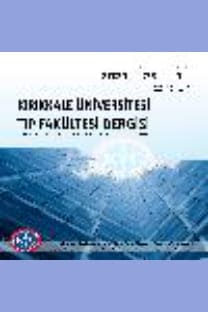DİREKT ETKİLİ ANTİVİRAL TEDAVİ ALAN KRONİK HEPATİT C HASTALARINDA ALFA FETOPROTEİN SONUÇLARININ DEĞERLENDİRİLMESİ
Alfa Fetoprotein, Kronik hepatit C, Direkt Etkili Antiviral Ajanlar
Evaluation of Alpha Fetoprotein Results in Chronic Hepatitis C Patients Who Received Directly Acting Antivral Treatment
___
- 1. Applegate TL, Fajardo E, Sacks JA. Hepatitis C virus diagnosis and the holy grail. Infectious Disease Clinics. 2018;32(2):425-45.
- 2. Morozov VA, Lagaye S. Hepatitis C virus: Morphogenesis, infection and therapy. World Journal of Hepatology. 2018;10(2):186-212.
- 3. Meringer H, Shibolet O, Deutsch L. Hepatocellular carcinoma in the post-hepatitis C virus era: Should we change the paradigm? World Journal of Gastroenterology. 2019;25(29):3929-40.
- 4. Alter HJ. The Gordon Wilson lecture: the hepatitis C virus: from Hippocrates to cure. Transactions of the American Clinical and Climatological Association. 2019;130:104.
- 5. Ferreira AR, Ramos B, Nunes A, Ribeiro D. Hepatitis C virus: evading the intracellular innate immunity. Journal of Clinical Medicine. 2020;9(3):790.
- 6. Zając M, Muszalska I, Sobczak A, Dadej A, Tomczak S, Jelińska A. Hepatitis C–New drugs and treatment prospects. European Journal of Medicinal Chemistry. 2019;165:225-49.
- 7. Coppola N, Alessio L, Onorato L, Sagnelli C, Macera M, Sagnelli E et al. Epidemiology and management of hepatitis C virus infections in immigrant populations. Infectious Diseases of Poverty. 2019;8(1):1-10.
- 8. Duran AÇ, Çetinkaya ÖK, Sayıner AA, Şeydaoğlu G, Özkarataş E, Abacıoğlu H. Changes on Hepatitis C virus genotype distribution in Western Turkey: Evaluation of twelve-year data. The Turkish Journal of Gastroenterology. 2020;31(2):128-35.
- 9. Younossi ZM, Racila A, Muir A, Bourliere M, Mangia A, Esteban R et al. Long-term patient centered outcomes in cirrhotic patients with chronic hepatitis C after achieving sustained virologic response. Clin Gastroenterol Hepatol. 2021:S1542-3565(21)00076-8.
- 10. Zhang M, Zhang L, Li H, Chen Z, Luo A, Liu B et al. Circulating T follicular helper cells are associated with rapid virological response in chronic hepatitis C patients undergoing peginterferon therapy. International Immunopharmacology. 2016;34:235-43.
- 11. Khan SZ, Talha MU, Iftikhar B, Noor A, Laique T, Latif A et al. Induction of combination therapy for the management of hepatitis C: An observational study. Cureus. 2020;12(9) e10259.
- 12. Wright C, Cogger S, Hsieh K, Goutzamanis S, Hellard M, Higgs P. “I'm obviously not dying so it's not something I need to sort out today”: Considering hepatitis C treatment in the era of direct acting antivirals. Infection, Disease & Health. 2019;24(2):58-66.
- 13. Asselah T, Marcellin P, Schinazi RF. Treatment of hepatitis C virus infection with direct‐acting antiviral agents: 100% cure? Liver International. 2018;38(Suppl 1):7-13.
- 14. Parola M, Pinzani M. Liver fibrosis: Pathophysiology, pathogenetic targets and clinical issues. Molecular Aspects of Medicine. 2019;65:37-55.
- 15. Manuc D, Preda CM, Sandra I, Baicus C, Cerban R, Constantinescu I et al. Signification of serum alpha-fetoprotein levels in cases of compensated cirrhosis and hepatitis C virus without hepatocellular carcinoma. Journal of Medicine and Life. 2020;13(1):68-74.
- 16. Khatun M, Ray RB. Mechanisms underlying hepatitis C virus-associated hepatic fibrosis. Cells. 2019;8(10):1249.
- 17. Rabaan AA, Al-Ahmed SH, Bazzi AM, Alfouzan WA, Alsuliman SA, Aldrazi FA et al. Overview of hepatitis C infection, molecular biology, and new treatment. Journal of Infection and Public Health. 2020;13(5):773-83.
- 18. Singal AG, Lim JK, Kanwal F. AGA clinical practice update on interaction between oral direct-acting antivirals for chronic hepatitis C infection and hepatocellular carcinoma: expert review. Gastroenterology. 2019;156(8):2149-57.
- 19. Tada T, Kumada T, Toyoda H, Mizuno K, Sone Y, Kataoka S et al. Improvement of liver stiffness in patients with hepatitis C virus infection who received direct‐acting antiviral therapy and achieved sustained virological response. Journal of Gastroenterology and Hepatology. 2017;32(12):1982-8.
- 20. Hu K-Q, Kyulo NL, Lim N, Elhazin B, Hillebrand DJ, Bock T. Clinical significance of elevated alpha-fetoprotein (AFP) in patients with chronic hepatitis C, but not hepatocellular carcinoma. Am J Gastroenterol. 2004;99(5):860-5.
- 21. Bayati N, Silverman AL, Gordon SC. Serum alpha-fetoprotein levels and liver histology in patients with chronic hepatitis C. The American Journal of Gastroenterology. 1998;93(12):2452-6.
- 22. Chen C-H, Lin S-T, Kuo C-L, Nien C-K. Clinical significance of elevated alpha-fetoprotein (AFP) in chronic hepatitis C without hepatocellular carcinoma. Hepato-gastroenterology. 2008;55(85):1423-7.
- ISSN: 2148-9645
- Yayın Aralığı: Yılda 3 Sayı
- Başlangıç: 1999
- Yayıncı: KIRIKKALE ÜNİVERSİTESİ KÜTÜPHANE VE DOKÜMANTASYON BAŞKANLIĞI
POPLİTEAL ARTER ANEVRİZMA CERRAHİSİNDE POSTERİOR VE MEDİAL YAKLAŞIM SONUÇLARININ KARŞILAŞTIRILMASI
Ufuk SAYAR, Muhammed Onur HANEDAN, Mehmet Ali YÜRÜK, Aşkın KILIÇ, Ali Kemal ARSLAN, İlker MATARACI
Hüseyin GEMALMAZ, Yıldırım GÜLTEKİN
Huzursuz Bacak Sendromlu Hastalarda Tibial Sinir İletimi
Kerim ÖNER, Muhammet Salih AYAS
Tayfun BİLGİÇ, Ali SÜRMELİOĞLU
TEKRARLAYAN ATEŞ ATAKLARI: MİRİZZİ SENDROMU OLGU SUNUMU
Ayşegül TUNA, Canver ÖNAL, Okan ÇALIŞKAN
Özgün KARAKUŞ, Ahmet Sinan SARI
Çocukluk Yaş Grubunda Rijit Üreteroskopi ve Lazer Litotripsi Sonuçlarımız
AHMET GÖKHAN GÜLER, Ali Erdal KARAKAYA, Ahmet Burak DOĞAN, Yaşar KANDUR
ÇOCUKLARDA TRAVMATİK PNÖMOTORAKS; BİR ÇOCUK TRAVMA MERKEZİNİN DENEYİMİ
Sabri̇ DEMİR, Ahmet ERTÜRK, Ayşe ERTOY, CAN İHSAN ÖZTORUN, Elif Emel ERTEN, Doğuş GÜNEY, Süleyman Arif BOSTANCI, Müjdem Nur AZILI, Fatih AKBIYIK, EMRAH ŞENEL
